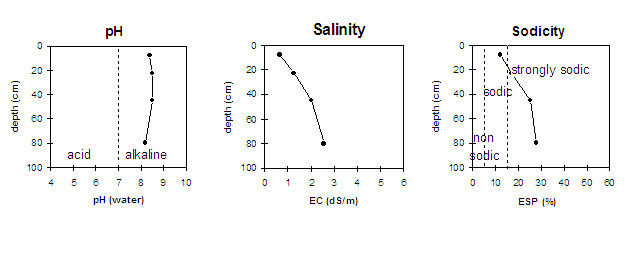LP8
This page is under construction and is not complete.
| Location: Cohuna | Australian Soil Classification: |
| Northcote Factual Key: | Great Soil Group: |
| General Landscape Description: Flat plain. | Local Name: Box Clay. |
Soil Profile Morphology:
Surface Soil
| A1 | 0-15 cm | Grey (10YR5/1); heavy clay; cracking and self-mulching surface condition; strong coarse blocky structure; very firm consistence moist; pH 8.4; sharp and smooth change to: | |
Subsoil | |||
| B21 | 15-30 cm | Grey (10YR6/1); medium heavy clay; weak consistence moist; contains a few (2%) soft carbonates as well as dark inclusions; pH 8.5; gradual change to: | |
| B22 | 30-60 cm | Greyish brown (2.5Y5/2); medium heavy clay; weak consistence moist; contains very few (2%) soft dark inclusions; pH 8.5; gradual change to: | |
| B23 | 60+ cm | Light brownish grey (2.5Y6/2) with brownish yellow (10YR6/6) mottles; heavy clay; lenticular structure; weak consistence moist; contains very few (2%) sulphate crystals in pockets as well as hard carbonate and dark inclusions coated with carbonate; pH 8.2. | |
Key Profile Features:
- High clay content throughout profile.
- Self-mulching and cracking surface condition.
- Accumulation of carbonates within the subsoil.
- Vertic properties (i.e. cracking surface condition and subsoil lenticular structure).
Soil Profile Characteristics:
 |
Management Considerations:
Whole Profile
- A very positive feature of this profile is that it has a high inherent fertility throughout which is beneficial to plant growth.
Surface (A) Horizon
- The surface horizon is self-mulching which provides a good seed bed that is friable and easily worked.
- When the soil is dry, heavy rains will move down soil cracks. This rapid recharge can be valuable for the survival of plants near wilting. When wet, the soil will swell and further infiltration will be relatively slow.
- Tillage of cracking clay soils should be avoided if the soil is wet (i.e. wetter than the plastic limit). At such a moisture condition, excessive tillage, trafficking or overstocking can result in structural degradation (e.g. compaction, smearing) occurring. Ideally, tillage should take place on clay soils such as these when the soil is drier than the plastic limit, down to at least the tillage depth.
- The surface (A1) is sodic and has a low exchangeable calcium to magnesium ratio (0.9) with complete dispersion after remoulding and immersing the soyl. This indicates that tillage or over-stocking of the soil whilst in a moist to wet condition may result in structural degradation (e.g. surface sealing, increased cloddiness) occurring. Raindrop action of bare soil may have a similar effect, so it is important to maintain surface cover. Gypsum application may assist in improving surface soil structural conditions on such soils.
- The levels of organic carbon measured at the pit site is low (this may or may not be representative of the whole paddock).
- The levels of total nitrogen measured at this pit site is moderate. However, this is best assessed by taking a bulked sample from across the paddock.
Subsoil (B) Horizons
- The upper subsoil (B21) is strongly sodic at 20 cm with a low exchangeable calcium to magnesium ratio (0.7). The high salinity level in the upper subsoil has probably contributed to the decrease in dispersion from strong to slight (after remoulding), however, root and water movement may still be restricted by soil pore spaces being filled in. Soil permeability will also be low due to the low porosity of the clayey horizons. Restricted drainage is also indicated by the presence of iron stone nodules.
- The subsoil is highly saline becoming extremely saline with depth and is likely to restrict the growth of salt sensitive plant species (e.g. faba beans, linseed, chickpeas and lupins).
- The subsoil (B23) displays vertic properties (lenticular structure etc.) which indicates that significant shrinking and swelling occurs with wetting and drying cycles. This may disturb the roots of some plant species and has engineering implications (e.g. disturbance to building foundations and fence lines).


